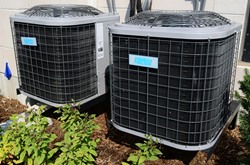How to Enroll In the Right HVAC Certification Class near Santa Paula California
 Once you have made a decision on a career as a heating and cooling technician, the next step is to find an HVAC trade school near Santa Paula CA. But with so many to pick from, how do you select the best one to receive the training that you need? A number of potential students will make their selection based entirely on the price of tuition or how near the school is to their residence. While these are significant factors to consider, they are not the only ones to take into account. Some of the other details that you need to investigate are the graduation completion rates of the HVAC schools, their reputations, and if they are accredited by professional trade organizations. Those and additional criteria will be addressed in more detail later in this article. But before we tackle how to select an HVAC trade school, let’s take a look at what a heating and cooling technician does to become a licensed professional tradesman.
Once you have made a decision on a career as a heating and cooling technician, the next step is to find an HVAC trade school near Santa Paula CA. But with so many to pick from, how do you select the best one to receive the training that you need? A number of potential students will make their selection based entirely on the price of tuition or how near the school is to their residence. While these are significant factors to consider, they are not the only ones to take into account. Some of the other details that you need to investigate are the graduation completion rates of the HVAC schools, their reputations, and if they are accredited by professional trade organizations. Those and additional criteria will be addressed in more detail later in this article. But before we tackle how to select an HVAC trade school, let’s take a look at what a heating and cooling technician does to become a licensed professional tradesman.
Becoming an HVAC Professional
 HVAC is an acronym that is extensively used in the trade that stands for “Heating, Ventilation and Air Conditioning”. HVAC professionals provide services for the installation, maintenance and repair of central air conditioners, furnaces, boilers, hot water heaters and heating systems. As professional tradesmen, they are typically mandated to be licensed, although every state and regional municipality has its own prerequisites. Attaining professional certification is not compulsory, but an alternative means for Santa Paula CA HVAC technicians to prove that they are highly skilled and accomplished in their area of expertise. There are multiple recognized certifications within the industry that are offered. Here are a few of the significant ones.
HVAC is an acronym that is extensively used in the trade that stands for “Heating, Ventilation and Air Conditioning”. HVAC professionals provide services for the installation, maintenance and repair of central air conditioners, furnaces, boilers, hot water heaters and heating systems. As professional tradesmen, they are typically mandated to be licensed, although every state and regional municipality has its own prerequisites. Attaining professional certification is not compulsory, but an alternative means for Santa Paula CA HVAC technicians to prove that they are highly skilled and accomplished in their area of expertise. There are multiple recognized certifications within the industry that are offered. Here are a few of the significant ones.
- North American Technician Excellence (NATE). NATE is a nationally recognized certification for HVAC techs. The certification is earned by passing a competency exam and may be earned in one or more specialties.
- HVAC Excellence. This certification makes available both a professional and a master specialist credential. 2 years of professional experience in addition to passing a comprehensive examination are required for the professional level certification. Master specialists need to have 3 years of experience as well as a passing result on the professional level exam. Similar to NATE, certifications are provided in multiple specialties.
- EPA Section 608. This certification is required for specialists that work with refrigerants. There are 3 forms of certification available, one for small appliances, and the other two for low and high pressure refrigerants.
Considering that licensing could be required in your area, and you may also intend to earn certification, it’s important that you enroll in an HVAC trade school that will train you for both. And since you will probably be working with refrigerants, make certain that the school you decide on preps you for passing the EPA Section 608 exams.
HVAC Degree and Certificate Courses
 There are a variety of alternatives offered for HVAC training in a technical or trade school. You can obtain a certificate, an Associate Degree, or a Bachelor’s Degree. Acquiring a certificate will take the lesser amount of time, often achieved in just six months, though some programs are longer. A certificate will train you for most HVAC positions, especially if you are licensed and have certification related to the position. The degree training programs might provide a competitive edge in the job market and will provide more extensive training than the certificate programs. Following is a brief summary of each credential offered near Santa Paula CA.
There are a variety of alternatives offered for HVAC training in a technical or trade school. You can obtain a certificate, an Associate Degree, or a Bachelor’s Degree. Acquiring a certificate will take the lesser amount of time, often achieved in just six months, though some programs are longer. A certificate will train you for most HVAC positions, especially if you are licensed and have certification related to the position. The degree training programs might provide a competitive edge in the job market and will provide more extensive training than the certificate programs. Following is a brief summary of each credential offered near Santa Paula CA.
- Certificate. Usually requiring a high school diploma, certificate programs are very popular among entry level commercial or residential HVAC professionals. They furnish a solid foundation of skills for job opportunities within the industry.
- Associate Degree. The Associate Degree in HVAC program supplies a more comprehensive knowledge of heating & cooling systems than the certificate program. Usually requiring 2 years to finish, some degrees incorporate an internship or work-study program.
- Bachelor’s Degree. The Bachelor’s Degree in HVAC is geared more towards a career in management or even business ownership. Some programs require an Associate Degree, while others are a traditional 4 year program. In addition to being taught how to service and maintain heating and cooling systems, you will also learn how to design them.
Selecting the ideal credential program will be based on what your long term career goals are, in addition to the time and financial resources that you have to commit. One approach is to begin with a certificate or perhaps an Associate Degree program, and after gaining some experience in the field in Santa Paula CA, subsequently returning to acquire a Bachelor’s Degree. If this is your strategy, make certain to ask the HVAC tech school you are considering about how their returning student program works.
HVAC Schools Online
 Enrolling in an HVAC program online is one possibility in getting your education and earning a degree or certificate. Almost all schools will call for some attendance on campus to participate in hands on training. Some also provide internship or work-study programs in addition to or as an alternative to practical lab work. But since the remainder of the classes may be attended on the web, this option may be a more practical solution for some Santa Paula CA students that are pressed for time. And some online degree programs are less costly than other on campus options. Even commuting expenses from Santa Paula and study materials may be lessened, helping to make education more budget-friendly. And numerous online schools are fully accredited (more on this later). So if your career or family commitments have left you with limited time to attend classes, perhaps an HVAC online training program will make it more convenient to fit school into your active schedule.
Enrolling in an HVAC program online is one possibility in getting your education and earning a degree or certificate. Almost all schools will call for some attendance on campus to participate in hands on training. Some also provide internship or work-study programs in addition to or as an alternative to practical lab work. But since the remainder of the classes may be attended on the web, this option may be a more practical solution for some Santa Paula CA students that are pressed for time. And some online degree programs are less costly than other on campus options. Even commuting expenses from Santa Paula and study materials may be lessened, helping to make education more budget-friendly. And numerous online schools are fully accredited (more on this later). So if your career or family commitments have left you with limited time to attend classes, perhaps an HVAC online training program will make it more convenient to fit school into your active schedule.
Questions For HVAC Certification Courses
 When you have chosen the type of certificate or degree that you want to obtain, either online or on campus, you can start to narrow down your list of schools. As you are no doubt aware, there are a large number of HVAC trade schools in the Santa Paula CA area and all over the United States to choose from. That’s why it is essential to have a checklist of important qualifications when making school assessments. As formerly mentioned in our opening paragraph, tuition and location will most likely be the first 2 factors you will take into consideration. Following are several additional ones that you should research before enrolling in your school of choice.
When you have chosen the type of certificate or degree that you want to obtain, either online or on campus, you can start to narrow down your list of schools. As you are no doubt aware, there are a large number of HVAC trade schools in the Santa Paula CA area and all over the United States to choose from. That’s why it is essential to have a checklist of important qualifications when making school assessments. As formerly mentioned in our opening paragraph, tuition and location will most likely be the first 2 factors you will take into consideration. Following are several additional ones that you should research before enrolling in your school of choice.
Accreditation. A large number of HVAC technical programs in the Santa Paula CA area have attained either a regional or a national accreditation. They may attain Institutional Accreditation, which involves the school’s programs overall, or Programmatic Accreditation, which relates to a specific program, such as HVAC technology. Confirm that the school is accredited by a U.S. Department of Education acknowledged accrediting organization, for instance the Accreditation Board for Engineering and Technology. Along with helping guarantee that you acquire a quality education, it may assist in obtaining financial assistance or student loans, which are frequently unavailable for non-accredited schools. Also, a number of states mandate that the HVAC training course be accredited for it to be approved for licensing.
High Completion Rates. Ask the HVAC schools you are reviewing what their completion rates are. The completion rate is the percentage or portion of students who enroll in and complete the course. A low completion rate might suggest that students were unhappy with the program and dropped out. It could also signify that the teachers were not qualified to instruct the students. It’s similarly important that the schools have higher job placement rates. Older and/or more reputable schools may have a more extensive list of graduates, which may mean more contacts for the school to employ for their apprenticeship and job placement programs. A high job placement rate can not only validate that the school has a good reputation within the trade, but also that it has the network of Santa Paula CA HVAC employers to assist graduates obtain apprenticeships or jobs.
Apprenticeship Programs. Numerous HVAC trade programs are taught together with an internship or an apprenticeship program. Those participating vocational and technical schools will help place you in an apprenticeship program within their network of Heating and Cooling contractors or trade unions. Find out if the schools you are reviewing have referring relationships with local Santa Paula CA HVAC specialists. An apprenticeship not only offers a valuable experience by providing hands-on training, but it also furnishes employment opportunities and helps to form relationships in the regional HVAC professional community.
Modern Facilities. Make certain that the campus facilities and the tools that you will be trained on are up-to-date and what you will be using on the job. If you are already in an internship or an apprenticeship, consult with the HVAC tech you are working with regarding what you should be looking for. If not, ask a local Santa Paula CA HVAC contracting company if they can give you some suggestions. Also bear in mind that unless you can relocate, the school needs to be within driving distance of your Santa Paula CA home. Remember that if you decide to attend an out-of-state school, in addition to moving costs there can be increased tuition charges compared to in-state residents.
Smaller Classes. It’s important that you receive as much personalized instruction as possible, which can be challenging in bigger classes. Ask if you can monitor some of the classes so that you can observe how large they are and experience the interaction between instructors and students. Talk with a few of the students and get their comments regarding class sizes and instruction. Finally, talk with a few of the instructors and find out what their level of experience is and what degrees or certifications they hold.
Flexible Scheduling. Confirm that the class schedules for the schools you are evaluating are flexible enough to handle your needs. If you can only go to classes in the evening or on weekends near Santa Paula CA, confirm that the schools you are considering offer those choices. If you can only attend part-time, make certain that the school you select offers part-time enrollment. Also, check out what the protocol is to make-up classes should you miss any due to work, sickness or family responsibilities.
Considering an HVAC School near Santa Paula CA?
Perhaps you are considering enrolling in an HVAC training program in the Santa Paula California area. If so, you may find the following background information about the location of your new school campus both interesting and informative.
Santa Paula, California
Santa Paula is a city in Ventura County, California, United States. Situated amidst the orchards of the fertile Santa Clara River Valley, the city advertises itself to tourists as the "Citrus Capital of the World."[12] Santa Paula was one of the early centers of California's petroleum industry. The Union Oil Company Building, the founding headquarters of the Union Oil Company of California in 1890, now houses the California Oil Museum.[12] The population was 29,321 at the 2010 census, up from 28,598 at the 2000 census.
The area of what today is Santa Paula was originally inhabited by the Chumash, a Native American people. In 1769, the Spanish Portola expedition, first Europeans to see inland areas of California, came down the Santa Clara River Valley from the previous night's encampment near Fillmore and camped in the vicinity of Santa Paula on August 12, near one of the creeks coming into the valley from the north (probably Santa Paula Creek). Fray Juan Crespi, a Franciscan missionary travelling with the expedition, had previously named the valley Cañada de Santa Clara. He noted that the party traveled about 9 to 10 miles (14 to 16 km) that day and camped near a large native village, which he named San Pedro Amoliano.[13] The site of the expedition's arrival has been designated California Historical Landmark No. 727.[14][note 1][note 2][15]
Franciscan missionaries, led by Father Junipero Serra, became active in the area after the founding of the San Buenaventura Mission and established an Asistencia; the town takes its name from the Catholic Saint Paula. Santa Paula is located on the 1843 Rancho Santa Paula y Saticoy Mexican land grant.
How To Become a HVAC Technician Santa Paula CA
Choosing the ideal HVAC school program is a crucial beginning toward a rewarding career in the heating and air conditioning trade. You originally came to this website because you wanted more information regarding How To Become a HVAC Technician. However, as we have covered in this article, you need to select an HVAC trade school and a degree or certificate program that are both accredited and have exceptional reputations within the HVAC field. Other factors to search for are ample hands-on training and state-of-the-art facilities. You need to check out each of the schools in person that you are most interested in to inspect the campus and speak with both the current students and faculty. Attempt to get a feel for the quality of the instruction and the interaction between them. Also, inquire about scheduling options and whether or not night or weekend classes are available if needed. And remember to inquire about financial assistance and student loan options also. If you ask the appropriate questions as we have outlined in our checklist for evaluating schools, you’ll be able to narrow down your choices so that you can make an informed decision. With the right training, hard work and dedication, you can eventually become a licensed HVAC specialist in Santa Paula CA.
More Hot and Cool Locations in California
Business Results 1 - 10 of 631












